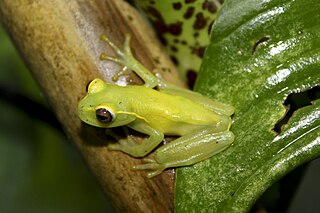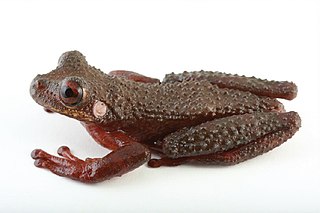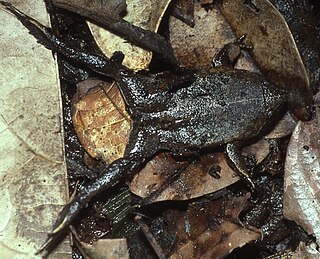
Hyloscirtus is a genus of Neotropical frogs in the family Hylidae. This genus was resurrected in 2005 following a major revision of the Hylidae, with the distinguishing features being 56 transformations in nuclear and mitochondrial proteins and ribosomal genes. Of these species, 28 species, previously placed in the genus Hyla, were moved to this genus. The fingers and toes of these frogs have wide dermal fringes.
Hyloxalus infraguttatus is a species of frog in the family Dendrobatidae. It is found on the Pacific slopes of Ecuadorian Andes at elevations of 70–1,500 m (230–4,920 ft) asl.

Hyloscirtus albopunctulatus is a species of frog in the family Hylidae found in Colombia, Ecuador and Peru. Its natural habitat is subtropical or tropical moist lowland forests.
Hyloscirtus alytolylax, called the babbling stream frog, babbling torrenter, or tadapi tree frog in English, is a species of frog in the family Hylidae found in Colombia and Ecuador. Its natural habitats are subtropical or tropical moist lowland forests, subtropical or tropical moist montane forests, and rivers. It is threatened by habitat loss. Scientists have observed it in Colombia between 500 and 2159 meters above sea level and in Ecuador between 400 and 2000 meters above sea level.

The La Loma tree frog is a species of frog in the family Hylidae found in Costa Rica, Panama, and expected but not confirmed in Colombia. Its natural habitats are tropical moist lowland and montane forests, with breeding taking place in streams. It is threatened by habitat loss and chytridiomycosis.
Linda's tree frog is a species of frog in the family Hylidae found in Colombia and Ecuador between 2000 and 2500 meters above sea level. Its natural habitats are subtropical or tropical moist montane forests, rivers, pastureland, rural gardens, and heavily degraded former forests. It is threatened by habitat loss.
The Rio Chingual Valley tree frog is a species of frog in the family Hylidae found in Colombia and Ecuador. Its natural habitats are subtropical or tropical moist montane forests, rivers, and heavily degraded former forests. Scientists have seen it between 1950 and 2700 meters above sea level.
The Pilalo tree frog is a species of frog in the family Hylidae endemic to Ecuador. Its natural habitats are subtropical or tropical moist montane forests and rivers. It has been observed between 2300 and 2600 meters above sea level. It is threatened by habitat loss.

Hyloscirtus tapichalaca is a species of frog in the family Hylidae. It is endemic to Ecuador and only known from the vicinity of its type locality in the Tapichalaca Biological Reserve, Zamora-Chinchipe Province. It is named after the type locality, which is a reserve owned by the Fundación de Conservación Jocotoco. Hyloscirtus tapichalaca belongs to the Hyloscirtus larinopygion group, although its placement with the group is uncertain; it may be the sister taxon of all other species in the group.
The El Pepino tree frog is a species of frog in the family Hylidae found in Colombia and Ecuador. Its natural habitats are subtropical or tropical moist lowland forests, subtropical or tropical moist montane forests, rivers, and swamps. It is threatened by habitat loss.

The Ecuador slender-legged tree frog is a species of frog in the family Hylidae found in Colombia and Ecuador. Its natural habitats are subtropical or tropical moist lowland forests, subtropical or tropical moist montane forests, rivers, intermittent freshwater marshes, rural gardens, and heavily degraded former forests.

Hyperolius castaneus is a species of frogs in the family Hyperoliidae. It is found in the highlands of western Burundi, Rwanda, and Uganda as well as eastern Democratic Republic of the Congo. Common names of this species include Ahl's reed frog, brown reed frog, and montane reed frog. The status of the putative subspecies Hyperolius castaneus rhodogaster is unclear, and it may actually be a distinct species. Also Hyperolius constellatus, now a distinct species, was formerly recognized as a subspecies of H. castaneus.
Strabomantis anomalus is a species of frogs in the family Strabomantidae. It is found in the Chocoan rainforests from near sea level to elevations of 1,180 m (3,870 ft) in northwestern Ecuador and western Colombia.
Pristimantis croceoinguinis is a species of frog in the family Strabomantidae. It is found in the lowland Amazon rainforest of southern Colombia, eastern Ecuador, and extreme north-eastern Peru, likely also extending into the adjacent Brazil. The specific name croceoinguinis refers to the color of the inguinal spots of this frog. Common name Santa Cecilia robber frog has been proposed for it.
Pristimantis modipeplus is a species of frog in the family Craugastoridae. It is endemic to the Andes of central Ecuador in Chimborazo, Pichincha, and Tungurahua Provinces. Common name Urbina robber frog has been proposed for it.
Pristimantis serendipitus is a species of frog in the family Craugastoridae. It is found in the Andes of northern Peru and adjacent southern Ecuador. The specific name refers to serendipitous discovery of this species: collection at the type locality was only made because the road was closed by an accident. Common name Colan Mountains robber frog has been proposed for this species.
Pristimantis variabilis is a species of frog in the family Craugastoridae. It is found in the lowland Amazon rainforest and Andean slopes in southern Colombia, eastern Ecuador, eastern Peru, and western Brazil. The specific name variabilis refers to the variable dorsal coloration of this frog. Common name variable robber frog has been proposed for it.

Engystomops coloradorum, also known as Colorado dwarf frog, is a species of frogs in the family Leptodactylidae. It is endemic to the Pacific lowlands and foothills of the Andes in the Pichincha and Santo Domingo de los Tsáchilas Provinces, Ecuador.

Ctenophryne geayi is a species of frog in the family Microhylidae. It is widely distributed in the northern parts of South America, in the Guianas and in the Amazon Basin in Venezuela, Colombia, Ecuador, Peru, Bolivia, and Brazil. It might actually represent two species.
Odorrana junlianensis, also known as the Junlian odorous frog, is a species of frogs in the family Ranidae. It is found in southern China and in the northernmost Laos and Vietnam. Its type locality is the eponymous Junlian County in Sichuan.








